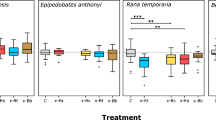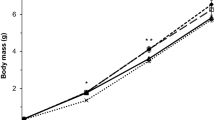Abstract
Bullfrogs (Rana catesbeiana), native to eastern North America, were introduced into Oregon in the 1930's. Bullfrogs are highly efficient predators that are known to eat a variety of prey including other amphibians. In laboratory experiments, we investigated whether juvenile Pacific treefrogs (Hyla regilla) recognize adult bullfrogs as a predatory threat. The ability of prey animals to acquire recognition of an introduced predator has important implications for survival of the prey. We found that treefrogs from a population that co-occurred with bullfrogs showed a strong avoidance of chemical cues of bullfrogs. In contrast, treefrogs from a population that did not co-occur with bullfrogs, did not respond to the bullfrog cues. Additional experiments showed that both populations of treefrogs use chemical cues to mediate predation risk. Treefrogs from both populations avoided chemical alarm cues from injured conspecifics.
Similar content being viewed by others
REFERENCES
ADAMS, M. J., and CLAESON, S. 1998. Field response of tadpoles to conspecific and heterospecific alarm. Ethology 104:955–962.
BLAUSTEIN, A. R., and WAKE, D. B. 1990. Declining amphibian populations: A global phenomenon? Trends Ecol. Evol. 5:203–204.
BLAUSTEIN, A. R., and WAKE, D. B. 1995. The puzzle of declining amphibian populations. Sci. Am. 272:52–57.
BURY, R. B., and WHELAN, J.A. 1986. Ecology and management of the bullfrog. U.S. Fish andWildlife Service, Resource Publication 155:1–24.
CHIVERS, D. P., and SMITH, R. J. F. 1994. The role of experience and chemical alarm signalling in predator recognition by fathead minnows, Pimephales promelas. J. Fish. Biol. 44:273–285.
CHIVERS, D. P., KIESECKER, J. M., ANDERSON, M. T., WILDY, E. L., and BLAUSTEIN, A. R. 1996. Avoidance response of a terrestrial salamander (Ambystoma macrodactylum) to chemical alarm cues. J. Chem. Ecol. 22:1709–1716.
CHIVERS, D. P., WISENDEN, B. D., and SMITH, R. J. F. 1996. Damselfly larvae learn to recognize predators from chemical cues in the predator's diet. Anim. Behav. 52:315–320.
CHIVERS, D. P., KIESECKER, J. M., WILDY, E. L., ANDERSON, M. T., and BLAUSTEIN, A. R. 1997. Chemical alarm signalling in terrestrial salamanders: Inter and intraspecific responses. Ethology 103:599–613.
CHIVERS, D. P., and SMITH, R. J. F. 1998. Chemical alarm signalling in aquatic predator-prey systems: A review and prospectus. Écoscience 5:338–352.
CHIVERS, D. P., KIESECKER, J. M., WILDY, E. L., BELDEN, L. K., KATS, L. B., and BLAUSTEIN, A. R. 1999. Avoidance response of post-metamorphic anurans to cues of injured conspecifics and predators. J. Herp. 33:472–476.
DUCEY, P. K., and BRODIE, E. D. Jr. 1991. Evolution of antipredator behaviour: Individual and population variation in a neotropical salamander. Herpetologica 47:89–95.
FLOWERS, M. A., and GRAVES, B. M. 1997. Juvenile toads avoid chemical cues from snake predators. Anim. Behav. 53:641–646.
HEWS, D. K., and BLAUSTEIN, A. R. 1985. An investigation of the alarm response in Bufo boreas and Rana cascadae tadpoles. Behav. Neural Biol. 43:47–57.
KATS, L. B., PETRANKA, J. W., and SIH, A. 1988. Anti-predator defenses and the persistence of amphibian larvae with fishes. Ecology 69:1865–1870.
KATS, L. B., and DILL, L. M. 1998. The scent of death: Chemosensory assessment of predation risk by prey animals: Écoscience 5:361–394.
KIESECKER, J. M., CHIVERS, D. P., and BLAUSTEIN, A. R. 1996. The use of chemical cues in predator recognition by western toad (Bufo boreas) tadpoles. Anim. Behav. 52:1237–1245.
KIESECKER, J. M., and BLAUSTEIN, A. R. 1997a. Population differences in responses of red-legged frog tadpoles (Rana aurora) to introduced bullfrogs. Ecology 78:1752–1760.
KIESECKER, J. M., and BLAUSTEIN, A. R. 1997b. Egg laying behavior influences pathogenic infection of amphibian embryos. Con. Biol. 11:214–220.
KIESECKER, J. M., and BLAUSTEIN, A. R. 1998. Effects of introduced bullfrogs and smallmouth bass on the microhabitat use, growth and survival of native red-legged frogs. Con. Biol. 12:776–787.
KUPFERBERG, S. J. 1997. Bullfrog (Rana catesbeiana) invasion of a California river: The role of larval competition. Ecology 78:1736–1751.
LIMA, S. L., and DILL, L. M. 1990. Behavioral decisions made under the risk of predation: A review and prospectus. Can. J. Zool. 68:619–640.
LUTTERSCHMIDT, W. I., MARVIN, G. A., and HUTCHINSON, V. H. 1994. Alarm responses by a plethodontid salamander (Desmognathus ochrophaeus): Conspecific and heterospecific "Schreckstoff". J. Chem. Ecol. 20:2751–2759.
MATHIS, A., and SMITH, R. J. F. 1993. Fathead minnows, Pimephales promelas, learn to recognize northern pike, Esox lucius, as predators on the basis of chemical stimuli from minnows in the pike's diet. Anim. Behav. 46:645–656.
MATHIS, A., CHIVERS, D. P., and SMITH, R. J. F. 1993. Population differences in responses of fathead minnows (Pimephales promelas) to visual and chemical stimuli from predators. Ethology 93:31–40.
MOYLE, P. B. 1973. Effects of introduced bullfrogs, Rana catesbeiana, on the native frogs of the San Joaquin Valley, California. Copeia 1973:18–22.
NUSSBAUM, R. A., BRODIE, E. D. JR., and STORM, R. M. 1983. Amphibians and reptiles of the Pacific Northwest. Univ. Idaho Press, Moscow, Idaho.
REZNICK, D. A., BRYGA, H., and ENDLER, J. A. 1990. Experimentally induced life-history evolution in a natural population. Nature 346:357–359.
RIECHERT, S. E., and HEDRICK, A. V. 1990. Levels of predation and genetically based antipredator behaviours in the spider, Agelenopsis aperta, Anim. Behav. 40:679–687.
SEGHERS, B. H. 1974. Schooling behavior in the guppy (Poecilia reticulata): An evolutionary response to predation. Evolution 28:486–489.
SIH, A. 1987. Predator and prey lifestyles: An evolutionary and ecological overview, pp. 203–224, in Kerfoot, W. C. and SIH, A. (eds.). Predation: Direct and indirect impacts on aquatic communities. Univ. Press of New England, Hanover.
SIH, A., and KATS, L. B. 1994. Age, experience, and the response of streamside salamander hatchlings to chemical cues from predatory sunfish. Ethology 96:253–259.
SIEGEL, S., and CASTELLAN, N. J. 1988. Nonparametric Statistics for the Behavioral Sciences, 2nd ed. McGraw-Hill, New York.
STEBBINS, R. C., and COHEN, N. W. 1995. A natural history of amphibians. Princeton Univ. Press, Princeton, New Jersey.
WERNER, E. E., WELLBORN, G. A., and MCPEEK, M. A. 1995. Diet composition in post metamorphic bullfrogs and green frogs: Implications for interspecific predation and competition. J. Herp. 29:600–607.
Author information
Authors and Affiliations
Rights and permissions
About this article
Cite this article
Chivers, D.P., Wildy, E.L., Kiesecker, J.M. et al. Avoidance Response of Juvenile Pacific Treefrogs to Chemical Cues of Introduced Predatory Bullfrogs. J Chem Ecol 27, 1667–1676 (2001). https://doi.org/10.1023/A:1010418526991
Issue Date:
DOI: https://doi.org/10.1023/A:1010418526991




